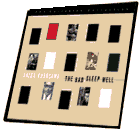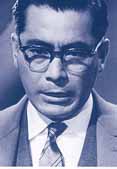
The Bad Sleep Well
Japan mystery
1960
bw 150 min.
Director: Akira Kurosawa
CLV: $69.95 - available
2 discs, catalog # CC1526L
VHS: available from Home Vision Cinema

A gray flannel ghost story in which the living haunt the dead, The Bad Sleep Well
remains the least appreciated of Akira Kurosawa's mid-period collaborations with Toshiro
Mifune -- a fate for which we have only the other Kurosawa/Mifune films to blame.
Out-swaggered by Yojimbo's rambunctious ronin, who skulked into the imaginations of
audiences the following year, and upstaged by the collaborators' final masterpiece, High and
Low -- in which Kurosawa's airtight storytelling and Mifune's anguished moralist/millionaire
confront the go-go nihilism of the Japanese New Wave, and find Noh way out -- The Bad Sleep
Well has kept to the shadows of the director's oeuvre. A fitting place, perhaps,
for a film whose bitter intent -- to throw open the windows of Japanese corporate corruption and
air out the stench -- is staged as a series of haltingly-revealed motivations, haggard resurrections,
and harrowing defeats. Fitting, but hardly fair.
The first film made by the director's own production company, The Bad Sleep Well falls
somewhere between the corporation noir of Robert Wise's Executive Suite and the cutthroat
industrial espionage of Yasuzo Masumura's Black Test Car: Fueled by personal anguish, a man
called Nishi (Mifune) concocts an elaborate plan to bring down a cabal of upper echelon
construction company men -- led by the implacable Iwabuchi (Masayuki Mori) -- with apparent ties
to the inner circles of Japan's highest government officials. Nishi's motivation: to avenge the
murder of the father he never knew, a mid-level executive driven to suicide to preserve his
superiors' positions. His method: infiltration by matrimony, as Nishi marries Iwabuchi's daughter
and becomes his father-in-law's apparent right-hand man.
From its opening scene, in which the high ceremony of the Nishi/Iwabuchi marriage is repeatedly
reduced to broad farce and lost face‹first by police detectives bearing a warrant for company
official Wada's arrest, then by the caustic commentary of a corps of tabloid reporters, eager to
wallow in the muck of unfolding scandal -- The Bad Sleep Well both announces its intentions
to defoliate decorum and expose impropriety, and admits the perils of individual action in the
face of fortified corporate will. Though silent for the film's first thirty minutes, Mifune's
stoic Nishi is the poker-faced fulcrum upon which every action and reaction pivots: the straight
man behind an ever-tightening noose of clever manipulations and manic reaction shots in a comedy
as black as a hanged man's tongue.
Much of that mottled mirth is written on the faces of the middlemen through whom Nishi hopes to
topple Iwabuchi: Kamatari Fujiwara's ashen Wada, Takashi Shimura's putty-mouthed Moriyama, and
Akira Nishimura's dehydrated Shirai. Were The Bad Sleep Well a costumed period piece -- easy
enough to imagine, really, as Mifune's vengeful Nishi is much like a shaved, showered and freshly
bespectacled Sanjuro, rewriting the ronin as a samurai without severance pay -- then these
three corporate stooges would no doubt appear as bamboozled bush boobs. In their buttoned-down
finery, they come across as even greater buffoons -- especially Nishimura, who gives the panicked
performance of a lifetime -- and Kurosawa exaggerates their hyper-theatrical descents into the
maelstrom with a fistful of greasepaint and a succession of loaded locales: shadow-choked suburban
lanes, demolished munitions factories, cryptlike bunkers, and a construction site that seems to
have opened a direct portal to Hell.
This being Kurosawa, there lies, of course, a moral question at the heart of the film: do Nishi's
ends -- exposing the evil that company men do -- justify his means? Is his merciless exploitation
of Iwabuchi's daughter, the haplessly handicapped Yoshiko, warranted to avenge his father's death
and strike a blow against institutionalized corruption?
Shatteringly, the film admits no solutions, and in this, it remains the most bleakly modern of
Kurosawa's black-and-white shadowplays: a pulverizing vortex of midnight phone calls and off-screen
murders which ultimately swallow the valorous and smother the innocent, while forever masking the
faces of the mighty and the malign. Kurosawa, however, responds to this facelessness in kind,
slashing at his invisible foes with a series of muscular set pieces and heroic visual designs.
Among them: a mysterious wedding cake in the shape of the office building from which Nishi's
father's was pushed, or thrown; a blisteringly Wellesian funeral, complete with mocking cha-cha
musical score, for a man not yet dead; and finally, in a room beneath the earth, a fallen
foundation beam that not only cuts the Tohoscope screen in half, but separates love from honor and
buries laughter below an avalanche of screams.
These, finally, are the real meanings of The Bad Sleep Well: a wide-eyed accumulation of
symbolic subversions and devastating distractions from what are perhaps the director's darkest
conclusions about the efficacy of individual heroics in the faceless modern age. How else to fell
a sleeping giant, when you're shackled to the shadow upon which it surely will land?
-- Chuck Stephens
Chuck Stephens writes for the San Francisco Bay Guardian, the L.A. Weekly,
and the Village Voice. He is also a frequent contributor to Film Comment.
Cast
Nishi: Toshiro Mifune
Iwabuchi: Masayuki Mori
Yoshiko: Kyoko Kagawa
Tatsuo: Tatsuya Mihashi
Moriyama: Takashi Shimura
Shirai: Akira Nishimura
Itakura: Takeshi Kato
Wada: Kamatari Fujiwara
Credits
Directed by Akira Kurosawa
Managing producer: Hiroshi Nezu
Assistant director: Shiro Moriya
Lighting by: Ichiro Inohara
Sound by: Fumio Yanoguchi,
Hisashi Shimogawa
Art direction by: Yoshiro Muraki
Cinematography by: Yuzuru Aizawa
Music score by: Masaru Sato
Scenario by: Hideo Oguni,
Eijiro Hisaita,
Akira Kurosawa,
Ryuzo Kikushima, and
Shinobu Hashimoto
Produced by: Tomoyuki Tanaka and
Akira Kurosawa
About the Transfer
The Bad Sleep Well is presented in its original Tohoscope aspect ratio of 2.35:1. This
new digital transfer was created from a 35mm composite fine-grain master.




